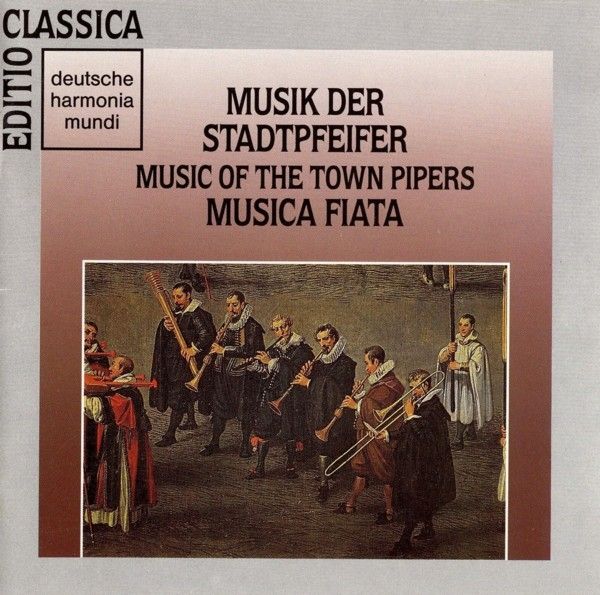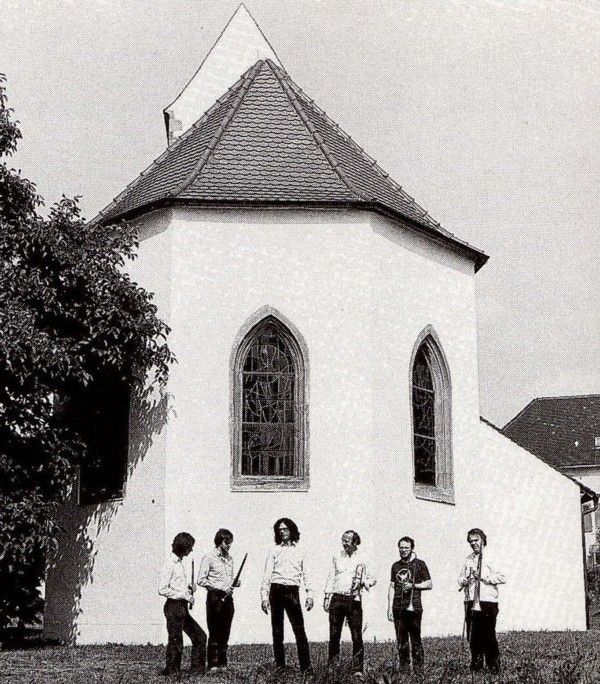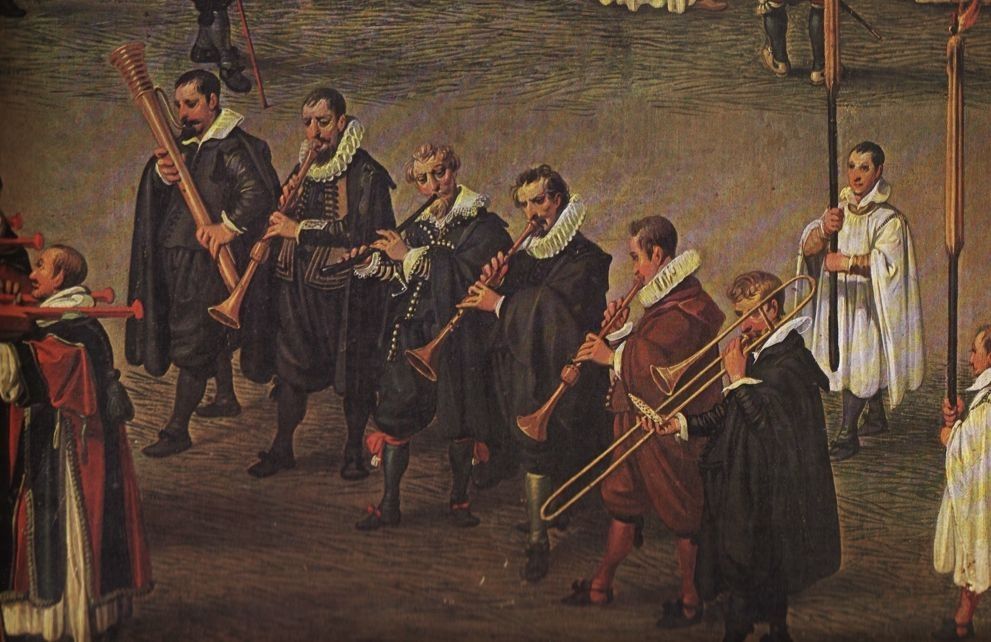
deutsche harmonia mundi / BMG
«editio classica» GD 77236
1982

deutsche harmonia mundi / BMG
«editio classica» GD 77236
1982
01 - Valentin HAUSSMANN (c.1570-1614). Intrada à 5 [1:48]
„Rest von polnischen und andern Tänzen ." 1603
02 - Christian ERBACH (c.1570-1635). Canzona à 4 [3:08]
03 - Giovanni Martino CESARE (c.1590-1667). „La Massimiliana" [3:05]
Due Cornetti à Violini · „Musicali Melodie"
1621
04 - Johann Hermann SCHEIN (1586-1630). Suite No. 7 à 5 [6:57]
Suite Nr.7 à 5 „Banchetto Musicale" 1617
Giovanni Martino CESARE. „Musicali Melodie" 1621
05 - „La Augustana" [3:44]
Cornetto é Trombone
06 - „La Fenice" [3:23]
Due Cornetti é due Tromboni
07 - Johann VIERDANCK (1605-1646). Sonata à 4 [3:12]
„Ander Theil ... Capricci, Canzoni e Sonaten" 1641
08 - Samuel SCHEIDT (1587-1654). Intrada à 5 [4:01]
„Ludi Musici" 1621
09 - Paul PEUERL (1570-1625). Canzona à 5 [2:15]
„Weltspiegel" 1613
10 - Giovanni Martino CESARE. „La Gioia" [3:10]
Due Cornetti è Violini é Trombone ·
„Musicali Melodie" 1621
11 - Isaac POSCH (m.1622). „Echo" Paduana à 5 [4:05]
„Musikalische Tafelfreudt" 1621
12 - Giovanni Martino CESARE. „La Foccarina"
[4:10]
Cornetto à Violino Solo · „Musicali Melodie"
1621
13 - Melchior VULPIUS (c.1570-1615). Magnificat Secundi Toni
à 5 [5:48]
MUSICA FIATA
Cornetto: Roland Wilson, Jeremy West
Alto cornetto: Roland Wilson
Alto trombone: Wolfgang König
Tenor trombone: Wolfgang König, Petet Sommer, Richard A.
Lister
Basso trombone: Richard A. Lister
Organo & regale: Christoph Lehmann
Instrumente
Cornetti von Roland Wilson nach einem Original aus dem
Musikinstrumentenmuseum Brüssel, von Christopher Monk nach einem
Original um 1620.
Alto cornetto von Roland Wilson sowie Alt-, Tenor- und Baßposaune
von Meinl und Lauber nach Originalen aus dem Germanischen
Nationalmuseum Nürnberg.
Orgel von B. Junghänel
Regal von R. Junghänel
Aufnahme: Dr. Benjamin Bernfeld
Schnitt: B. Bemfeld jun.
Technik/: harmonia mundi acustica
Aufgenommen: 16.-18. t/II. 1982, St. Petruskirche in Blasingen

Music of the
"Stadtpfeifer"
From the 13th century onwards larger cities began to take musicians
into their employment, the word "Stadtpfiffer" first appearing in the
next century. Other equivalent names which also appear at this time
include Ratsmusikant, Stadtmusikant and Zinkenist. Stadtpfeifer (lit.
"city piper") were the German equivalent of the English "city waits".
By the second half of the 16th century even smaller cities had their
Stadtpfeifer bodies and towards the end of the century the ensembles
also began to increase in size.
The duties and rights of the musicians were officially laid down in
contracts between them and the town council. The post as Stadtpfeifer
was often combined with that of watchman, and an important part of
their duties consisted of playing from the church tower at specific
hours of the day. Other duties included providing the music at official
banquets and celebrations, playing on feast days in the church or, for
example in Bremen, being obliged to entertain the market traders for an
hour on market days with music played on cornetts and trombones. Apart
from performing their civic duties, for which they were not
particularly well paid, the Stadtpfeifer supplemented their income by
exercising their exclusive right to provide music for private functions
such as weddings, citizens only being allowed to engage other musicians
if the Stadtpfeifer were not available.
The Stadtpfeifer learnt their trade like any other, by spending five or
six years as an apprentice and then becoming a journeyman for a number
of years, after which he was able to apply for a position as
Stadtpfeifer if one fell vacant. Although they were required to be
proficient on all the wind and string instruments of the time, the wind
instruments tended to predominate in their music. Cornett and
sackbutts, on account of their noble sound, were held to be superior
and in some cities were reserved for the upper classes, the lower
classes having to make do with string music at their festivities.
In the first quarter of the 17th century two different foreign
influences made themselves felt on German instrumental music which were
to play an important part in it's future. In the north a number of
English musicians came to settle in Germany at this time, foremost
among them William Brade and Thomas Simpson, who, with their
publications of dances, played a major role in the development of the
dance suite. In the south the influence of Italian music and musicians
predominated, bringing with it firstly the instrumental canzona and
later the sonata. Outstanding among the numerous publications of dances
at this time were the twenty suites published in 1617 by Johann Hermann
Schein, a few months after his appointment as Thomaskantor in Leipzig,
under the title of "Banchetto Musicale". Each suite consists of two
pairs of dances — padouana-gagliarda and allemande-tripla —
with a courente between them. These are united by key, and in some
cases, thematically. Of these, the first pair had become stylised
instrumental pieces far removed form their origins as dances. In
particular, the padouana was regarded as a free instrumental
composition, which, in it's complex polyphonic style, was closely
related to the English viol fancies. The English influence is
particularly clear in the case of the suite on this record, which uses
a cantus firmus technique, reminiscent of English "In Nomine"
compositions. The other dance pair, allemande and tripla, of which the
latter is merely a rhythmic variation of the former, represents an
antithesis to the first pair, the simple, peasant-like dance music of
the second pair contrasting sharply with the artistic invention of the
first. Between the two extremes comes the courente, which, although
rhythmically more complicated and more polyphonic than the
allemande-tripla, is clearly recognisable as a dance.
Closely related to the pavane, although more homophonic, was the
intrada, represented here by compositions from Valentin Haussmann and
Samuel Scheidt. One can easily imagine the former being used, as the
intrada originally was, as a short introductory piece for dances or
other festivities, whereas the latter, while retaining the same
character, has developed into a piece of artistic invention.
"Echo" canzonas were fairly common in Italy at this time and this
device is used to good effect by Isaac Posch in the padouana played
here. As dynamic markings were not very common at this time, Posch felt
obliged, in the introduction to his "Musicalische Tafelfreudt", to
explain the meaning of the signs P. and F.
The vocal origins of the instrumental canzona are unmistakeable in the
canzona by Paul Peuerl. Published in a collection otherwise containing
vocal music, it could equally well be sung as be played. The canzona by
Christian Erbach is, however, more instrumental in conception. It shows
his close acquaintance with Italian music, including a short section
which makes use of a "battaglia"-type rhythm similar to that used in
the many pieces of that name.
The fourteen instrumental pieces contained in Giovanni Martino Cesare's
"Musicali Melodie" were named neither canzonas nor sonatas by the
composer. The titles of the pieces are merely dedications such as "La
Foccarina" (for the Fugger family), or descriptive e.g. "La Gioia" (the
joy). Although most of them begin with the typical canzona rhythm, they
distinguish themselves from the canzonas of Peuerl and Erbach in a
number of ways, typical of the Italian sonata of this time. Firstly,
the basso continuo part, instead of simply following the lowest part,
is often completely independent and makes, for example in "La
Augustana" a trio out of a piece entitled "a 2". Secondly instead of
the old soprano, alto, tenor, bass scoring, there is a clear
treble-bass contrast. Thirdly, an increased emphasis of the affections,
requires from the performer varied tempi, dynamics, and articulation,
although these are not specified by the composer. The writing is also
typically instrumental, including wide, melodic leaps and virtuoso
passage-work which would have been beyond the capabilities of all but
the very best Stadtpfeifer.
The "Sonata à 4" by Johann Vierdanck, in which a concerted solo
part for the cornet is contrasted with a tutti of three trombones, has
been called the first German solo concerto. It is wonderfully conceived
in terms of the instruments it is written for, the majestic sound of
the trombone trio combining perfectly with the more agile cornett,
which incorporates into it's part diminutions in the old Italian
tradition.
The church duties of the Stadtpfeifer are represented here by a
performance of the Magnificat à 5 by Melchior Vulpius. It is the
only untexted Magnificat out of the twelve by him, contained in the
Pelplin Organ Book, and may have been intended for instrumental
performance, the individual movements being played between sung
sections of the Magnificat.
Roland Wilson
Giovanni Martino Cesare (ca. 1590-1667) was employed as a
cornettist at the court of Duke Maximilian in Munich. Vocal works by
him also appear in important anthologies of the time.
Christian Erbach (ca. 1570-1635) enjoyed a wide reputation as
teacher, organist, and composer of both vocal and instrumental music in
his day. He spent all his working life in Augsburg, where he was for
some years head of the Stadtpfeifer.
Valentin Haussmann (ca. 1570-1614) published numerous
collections of dance-songs and instrumental dances, which mark a
landmark in the development of German instrumental music.
Isaac Posch († 1622 or 23) and Paul Peuerl
(1570-1613) both worked as organists and organ builders in Austria, and
both made a significant contribution to the development of the dance
suite.
Samuel Scheidt (1587-1654) and Johann Hermann Schein
(1586-1630) are held, together with Heinrich Schütz, to be the
most important composers of the German early Baroque period. Most of
Scheidt's instrumental ensemble music has been lost, and his fame now
rests mainly on his organ music. Schein's instrumental music
represented only a small part of his output but in this genre, as in
every other, he showed himself to be a great master.
Johann Vierdanck (1605-1646) was a choirboy under Heinrich
Schütz and was later employed as a violinist and cornettist in the
Dresden Hofkapelle before taking up an appointment as organist in
Stralsund.
Melchior Vulpius (ca. 1570-1615) was an important composer of
Lutheran church music, writing 400 hymns and almost 200 motets.
MUSICA FIATA
was founded in 1976 as an ensemble specializing in the performance of
16th and 17th century music on historical instruments. An intensive
study of performance practice sources, playing techniques and original
instruments of the period has enabled the group to develop an
appropriate musical style which differs considerably from that of the
late-baroque. Tensely-strung violins, playing with light, short, bows
which favour a speech-like articulation, authentic mouthpieces for the
cornetts and sackbutts, which produce a clear brilliant sound, and
performing at chorton pitch (ca. a semitone higher than modern pitch)
all contribute to Musica Fiata's unique sound.
The group is based in Cologne and apart from giving concerts in
Germany, Musica Fiata has performed in Spain, Italy, Israel, Belgium,
Holland, Switzerland, France, Austria, Sweden and Finnland. The
ensemble's exemplary performances have resulted in invitations to the
most important festivals throughout Europe.
